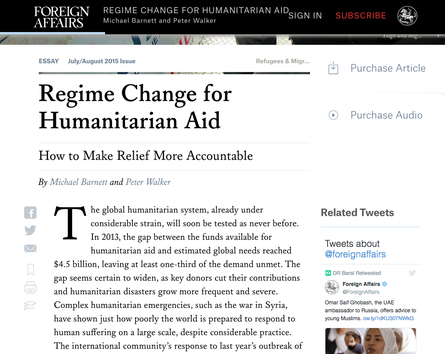
The global humanitarian system, already under considerable strain, will soon be tested as never before. In 2013, the gap between the funds available for humanitarian aid and estimated global needs reached $4.5 billion, leaving at least one-third of the demand unmet. The gap seems certain to widen, as key donors cut their contributions and humanitarian disasters grow more frequent and severe. Complex humanitarian emergencies, such as the war in Syria, have shown just how poorly the world is prepared to respond to human suffering on a large scale, despite considerable practice. The international community’s response to last year’s outbreak of Ebola in West Africa, for example, was slow off the mark and then stumbled, leaving everyone worried about future public health emergencies. Meanwhile, climate change has increased the destructive force of natural disasters, which fuel violence and put tremendous pressure on governments and aid agencies alike. And rapid urbanization, coupled with massive migration to coasts, has amplified the toll of such crises.
Links
Resource collections
- Accountability to affected populations (AAP)
- ALNAP focus topics
- UN Habitat - Urban Response Collection
- Urban Response - Urban Crisis Preparedness and Risk Reduction
- Urban Response Collection - Community Engagement and Social Cohesion
- Urban Response Collection - Economic Recovery
- Urban Response Collection - Environment and Climate Change
- Urban Response Collection - Housing, Land and Property
- Urban Response Collection - Urban Crisis Response, Recovery and Reconstruction
- Urban Response Collection - Urban Resilience